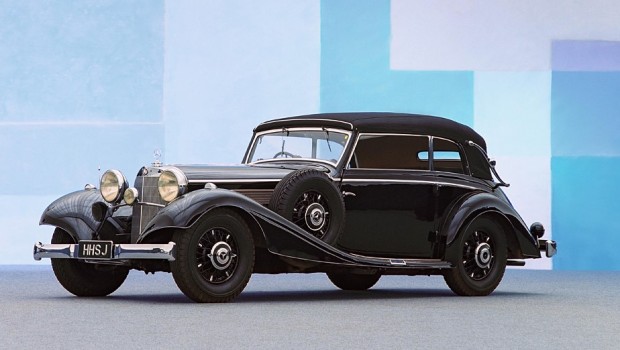Mercedes-Benz 540 K Spezial Cabriolet A
Released at the Paris Motor Show in 1936, the 540K became Mercedes-Benz’s flagship model and was built by special order only. It followed the eight cylinder 500K and helped maintain the company’s prestige by being one of the fastest production cars in the world.
At the Paris Motor Show, Mercedes-Benz said the 540K name ”conjures up visions of breath-taking exploits of racing cars and drivers of international fame, but also of superlative comfort and coachwork of exquisite beauty, fine paintwork, brightly polished metal, the finest hardwoods and leather – massive and yet outstandingly attractive bodies – in short: the car for the connoisseur.”
Each car was individually built to the customer’s needs and Mercedes-Benz prepared a range of available bodies. Among these, were the spectacular Spezial Roadsters built Mercedes-Benz’s own Karrosserie Sindelfingen. These flowing two-seaters were one of the most striking prewar designs, distinguished by their prominent hood, sweeping fenders, external exhaust pipes, raked windscreen and extreme length. The are still, arguably, the most beautiful German supercars and have a commanding presence.
Engineer Gustav Rohr was responsible for designing the 540K cruisers and upgraded them while he also worked on the incredible Mercedes-Benz Grand Prix cars. He fitted an enlarged 5.4 litre inline-8 which was good for 180hp and 170 kph. The main highlight of the engine was its gear driven, Rootes-type supercharger (or Kompressor) which would spool up on demand to increase the avilable power from 115bhp to 180bhp when engaged. This setup was a similar to the supercharged S, SS and SSK racecars which were designed by Ferdinand Porsche to help Mercedes-Benz dominate racing in the twenties.
When built, the 540K featured an updated chassis with a longer wheelbase that extended the hood and allowed for a new vee-shaped radiator. Rohr also included better suspension and braking. Like the earlier cars, the suspension was also fully independent.
Factory records show that 419 of these cars were built and featured a wide array of coachwork. Surprisingly, most were built by the factory’s own Karrosserie Sindelfingen which was managed by Wilhelm Haspel. They offered a variety of Cabriolet bodies that were designated ‘A’ through ‘D’. These were joined several coupes designs and the very coveted Special Roadsters.


















